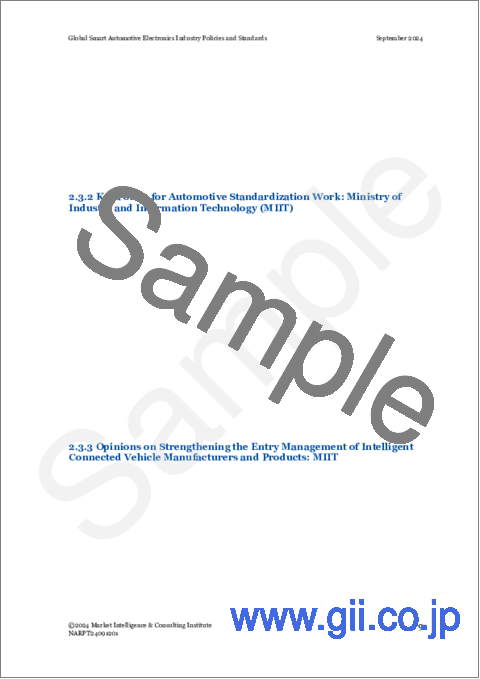|
|
市場調査レポート
商品コード
1557672
世界のスマートカーエレクトロニクス業界の政策と基準Global Smart Automotive Electronics Industry Policies and Standards (pre-order) |
||||||
|
|||||||
| 世界のスマートカーエレクトロニクス業界の政策と基準 |
|
出版日: 2024年09月12日
発行: MIC - Market Intelligence & Consulting Institute
ページ情報: 英文 21 Pages
納期: 3~5営業日
|
- 全表示
- 概要
- 図表
- 目次
技術が成熟し、生活習慣が進化し、環境や持続可能性の問題が重要性を増し、新興企業が業界に参入するにつれ、自動車業界は変革に直面しています。自動車産業は、C.A.S.E. (コネクテッド、自動運転、シェアリング、電動化) 市場への移行が進展しつつあります。当レポートでは、スマートカーエレクトロニクスの定義や業界の動向、主要な政策と規格について詳細に検証すると共に、世界各国のスマートカーエレクトロニクス業界における政策や規格を詳細に調査しています。当レポートではまた、世界の主要国・地域のスマートカーエレクトロニクス関連政策を包括的にレビューし、関連する標準化規制についても重点的に分析しています。
目次
第1章 スマートカーエレクトロニクスの発展
- スマートカーエレクトロニクスの定義と範囲
- スマートカーエレクトロニクスの主要業界の動向
第2章 スマートカーエレクトロニクスの主要政策
- 米国
- サイバーセキュリティとデータ:コネクテッドカー調査
- 三電システムと原材料:税額控除の制限
- 車両製造:新たな関税規制
- 自動運転技術:インセンティブ政策
- 欧州連合 (EU)
- 中国
- 交通分野での科学技術イノベーションの中長期発展計画 (2021~2035年) の概要
- 自動車標準化作業のポイント:工業情報化部 (MIIT)
- インテリジェントコネクテッドカー・メーカーと製品の参入管理強化に関する意見:工業情報技術部
第3章 スマートカーエレクトロニクスの主要規格
- UN R156:ソフトウェア更新基準
- システム管理要件
- リスク管理
- ソフトウェア開発・管理
- 更新プロセス
- セキュリティ対策
- 文書と記録
- ユーザー通知とサポート
- 監視と継続的な改善
- EURO 7/VII:車両のライフサイクル全体をカバーする炭素排出基準
- UN R155:初の自動車向けサイバーセキュリティ規格
- SaFAD:自動運転開発の業界標準
第4章 結論
- コネクティビティと自動運転が、自動車用エレクトロニクス政策の主な焦点となる
- 自動車用エレクトロニクスの規格:安全性・信頼性・環境保護を重視
付録
- 企業一覧
List of Figures
- Figure 1: Scope of Smart Cockpit
- Figure 2: Penetration Rate of Smart Cockpits in New Vehicles
- Figure 3: Diagram of Relationships Between Cybersecurity-Related Standards
As technology matures, lifestyle habits evolve, green and sustainable issues gain momentum, and startups join the industry, the automotive sector is facing a transformation. It is moving towards the Connected, Autonomous, Sharing, and Electrified (C.A.S.E.) market trend. This report provides an in-depth analysis of global policies and standards within the smart automotive electronics industry, covering the definition of smart automotive electronics, industry development trends, and a detailed examination of key policies and standards. The research comprehensively reviews policies related to smart automotive electronics from major countries and regions worldwide, with a focused analysis on relevant standardization regulations.
Table of Contents
1. Development of Smart Automotive Electronics
- 1.1 Definition and Scope of Smart Automotive Electronics
- 1.2 Key Industry Trends in Smart Automotive Electronics
2. Key Policies of Smart Automotive Electronics
- 2.1 The United States (US)
- 2.1.1 Cybersecurity and Data: Connected Vehicle Survey
- 2.1.2 Three-electric System and Raw Materials: Tax Credit Limitations
- 2.1.3 Whole-Vehicle Manufacturing: New Tariff Regulations
- 2.1.4 Autonomous Driving Technology: Incentive Policies
- 2.2 The European Union (EU)
- 2.3 China
- 2.3.1 Outline of the Medium- to Long-Term Development Plan for Scientific and Technological Innovation in the Transportation Field (2021-2035)
- 2.3.2 Key Points for Automotive Standardization Work: Ministry of Industry and Information Technology (MIIT)
- 2.3.3 Opinions on Strengthening the Entry Management of Intelligent Connected Vehicle Manufacturers and Products: MIIT
3. Key Standards of Smart Vehicle Electronics
- 3.3 UN R156: Software Update Standards
- 3.3.1 System Management Requirements
- 3.3.2 Risk Management
- 3.3.3 Software Development and Management
- 3.3.4 Update Process
- 3.3.5 Security Measures
- 3.3.6 Documentation and Records
- 3.3.7 User Notification and Support
- 3.3.8 Monitoring and Continuous Improvement
- 3.4 EURO 7/VII: Carbon Emission Standards Covering the Entire Vehicle Lifecycle
- 3.5 UN R155: First Cybersecurity Standard for Vehicles
- 3.6 SaFAD: Industry Standard for Autonomous Driving Development
4. Conclusion
- 4.1 Connectivity and Autonomous Driving as the Main Focuses of Autonomous Electronics Policies
- 4.2 Autonomous Electronics Standards Emphasize Safety, Reliability, and Environmental Protection
Appendix
- List of Companies






